How big is Space and What can you see?
Numbers
Space (the Universe) is big.
Very big. Very very big.
No matter how many “verys” you put it would still not describe anywhere near just how big space is.
To describe space we need some big numbers like thousands, millions, billions, trillions. But these numbers are quick to say and still give you no idea how big these numbers are.
Let’s suppose you have a button to press that counts up on a screen, and you press the button once every second. To count to a hundred would take 100 seconds, just one minute 40 seconds.
To count to a thousand would take about 17 minutes, to a million would take about 11 days 14 hours. A billion is a thousand millions and would take 32 years, and a trillion is a thousand billions and so would take 32,000 years! Later you will meet a galaxy that has about a trillions stars.
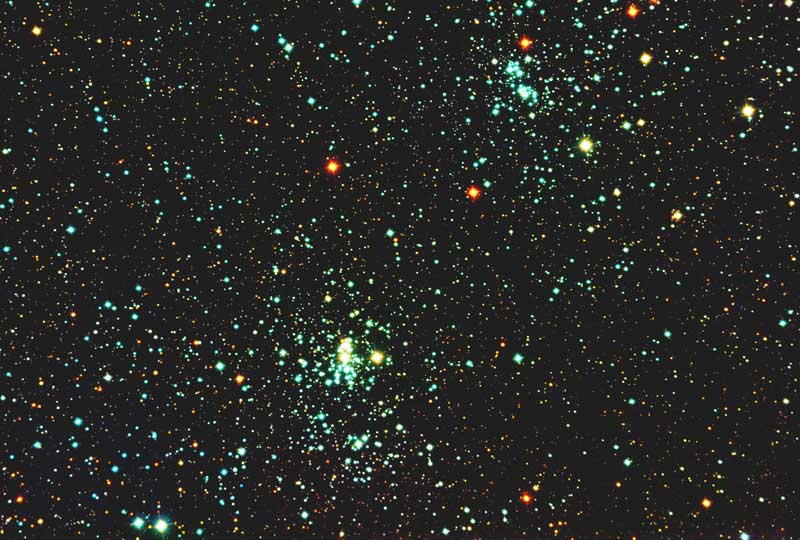
Distances
You wake up one morning to hear a peculiar noise from a patch of bare ground nearby. Out of the window, very surprisingly, you see a rocket obviously just landed. It looks similar to the rockets that you see every so often on the television. A door opens and a little green man steps out. He seems to have learned English and says a polite “Good Morning”. You ask where he has come from and he replied it is from a planet orbiting one of the nearest stars. You have a conversation over coffee and toast – which he obviously appreciates – and he tells you he is over 8000 years old and it has taken him most of that time to get here. Over that last 50 years he tells you that he has picked up radio transmissions from the Earth and he has used that to learn English.
You realise that this means the nearest star is a long way away. In kilometers it as about 38 trillion!
It makes it very hard to describe distances with such big numbers. Something different is needed. To get a new way of measuring distance we use the fact that light travels very fast at 300,000 kilometers every second. The moon is 384,400 kilometers from Earth, so light takes about 1.3 seconds to get to the moon. When the American astronauts were on the moon, to get a reply from a question takes about 2.6 seconds if they reply straight away.
We say that the Moon is 1.3 light seconds away. The Sun is about 8 light minutes away. So if you look at the sun (using special dark glasses of course) you are seeing it as it was 8 minutes ago – the time light takes to travel the 150,000,000 kilometers from Sun to Earth.
In your conversation with the little green man it works out that with the speed he has been travelling at and the total journey time, that he has come a distance of about 38 trillion km! Doing a few sums, it works out that light takes about 4.2 years to travel this distance. So we say that he has travelled a distance of 4.2 light years.
Light years are used as unit of measuring distance once we are talking about the nearest stars and anything further way. One light year is about 9.5 trillion kilometers.
Areas of space
There are three distinct area that we can see when we look into the night sky.
- The Solar system. This contains the Sun, Planets – Mercury, Venus, Earth, Mars, Jupiter, Saturn, Uranus and Neptune. Pluto is futher away and there is dispute whether it is a genuine planet or not.
- Our Own Galaxy. This is called the Milky Way Galaxy for reasons explained later. It contains all the stars we can see and other objects, nebulae and globular clusters are examples. In relation to the solar system the Milky Way galaxy is huge. Later there is some attempt at trying to give an idea of the distances involved.
- Galaxies beyond. Well beyond the confines of the Milky Way there are other galaxies complete in themselves. These may contain billions, and some contain trillions, of stars. Again relative to their size they are (mostly) at very large distances apart. These galaxies, of which there are billions, comprise the known universe.
Each of these three “areas” are huge and dwarf one another. And dwarf is not really a powerful enough word. The Milky Way galaxy dwarfs the Solar System. The universe of Galaxies totally dwarfs the single Milky Way galaxy in which our Sun lives.
1.THE SOLAR SYSTEM
The sun with the planets encircling is very large when we think about travelling to the planets. But it is tiny compared to the distance of even the nearest star. Pluto – the furthest planet* is about 4.8 light hours away on average.

In Ireland on the Kerry Way walk there is a section which helps get a picture of how the sun and planets are situated in the solar system.
The walk starts with a metal structure indicating the size of the sun to the scale of the walk.
All of the planets are shown to scale inside a frame representing the size of the sun.
As you walk along the path you first come to the planet Mercury with is about 27 metres along the walk. The size of Mercury on this scale is shown by the tiny ball bearing mounted in the sun size frame. Next you come to Venus and then about 90 metres along the path you come to Earth. It is about the size of a pea!

You then pass Mars and Jupiter. This shows the relative size of Jupiter and you are now 400 metres along the path.
Jupiter is the biggest planet and is the size of a small tennis ball on this scale.
From now on the planets get further and further apart as you pass Saturn, Uranus and Neptune. Finally, you get to Pluto at 3.5km from the start. That is 3,500 metres from the Sun compared with the Earth at just 90 metres away on this scale.
From the scale and the sizes of the model planets you can see that the Solar System is very much empty space, and that the Earth is pretty close to the Sun compared with the much larger distance to walk to the outer planets.
The Sun and Moon
If you want to know more about the individual planets then that is something to look up on the internet. Here there are just few details about the Sun and Moon. These are the two objects in the sky that we see regularly and which appear big enough to appear as discs.
The Sun
The Sun is an average star. All the stars we see give out heal and light like the Sun. Some are much bigger, others are smaller. The Sun, our star is at the centre of the Solar System. It is a nearly perfect sphere of hot plasma, heated to incandescence by nuclear fusion reactions in its core, radiating the energy mainly as visible light, ultraviolet light, and infrared (heat) radiation.
The Sun’s core fuses about 600 million tons of hydrogen into helium every second, converting 4 million tons of matter into energy every second as a result. When hydrogen fusion in its core has diminished to a much lower level the Sun will expand into a red giant. It is calculated that the Sun will become sufficiently large to engulf the current orbits of Mercury and Venus, and render Earth uninhabitable – but not for about five billion years.
The Photosphere
The visible surface of the Sun is called the photosphere. Although the sun is a plasma we cannot see into the sun beyond this. The photosphere is tens to hundreds of kilometres thick.
Sunspots are temporary phenomena on the Sun’s photosphere that appear as spots darker than the surrounding areas. They are regions of reduced surface temperature caused by concentrations of magnetic field that prevent heat from spreading evenly. Sunspots usually appear in pairs, one behaving rather like a North magnetic pole and the other like a South pole. Sunspots may last anywhere from a few days to a few months, but eventually decay. Sunspots expand and contract as they move across the surface of the Sun, with diameters ranging from 16 km to 160,000 km. Larger sunspots can be visible from Earth without the aid of a telescope but you must have special dark glasses. Sunspots observed on successive days will appear in different positions due to the rotation of the sun. The sun is not a solid object, and the period of rotation is around 38 days near the poles and about 25 days near the equator.
The Chromosphere.
This is a layer above the Photosphere. Without special equipment, the chromosphere cannot normally be seen due to the overwhelming brightness of the photosphere beneath. Most of light from the chromosphere is emitted by hydrogen atoms undergoing a particular atomic transition which emit a very narrow band of wavelengths. This is known as Hydrogen-alpha light. So to see the chromosphere the telescope needs to have a special filter that only allows this narrow band of wavelengths.
Many interesting phenomena can be observed in the chromosphere, which is very complex and dynamic:
Filaments (and prominences, which are filaments viewed from the side). Solar prominences rise up through the chromosphere from the photosphere, sometimes reaching altitudes of 150,000 km. These gigantic plumes of gas are the most spectacular of solar phenomena, (aside from the less frequent solar flares.)
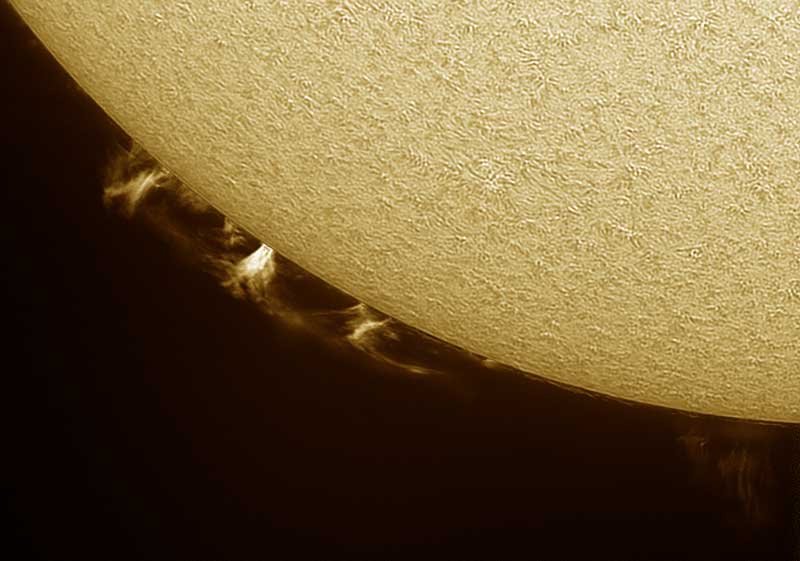
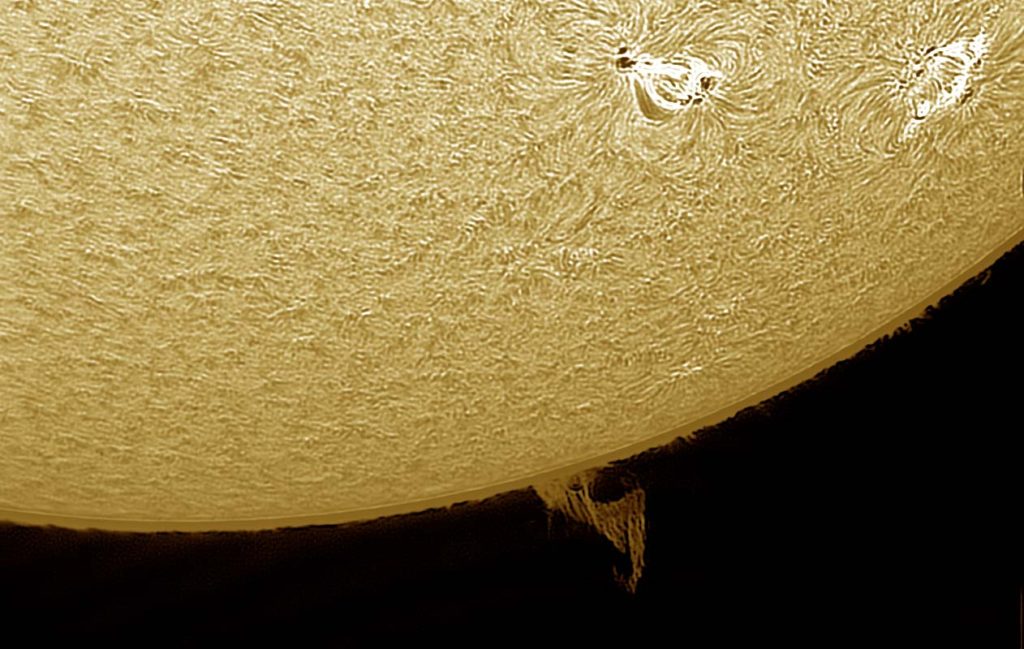
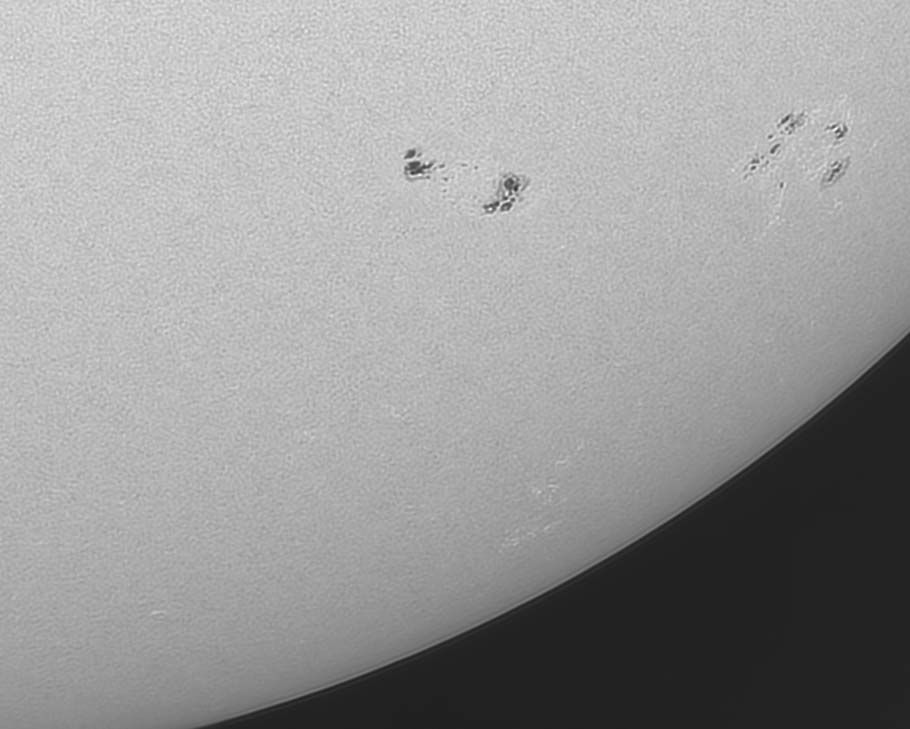
A group of solar prominences.
Two sunspot groups (and a prominence) seen with a filter only allowing Hydrogen-alpha light.
The same group of sunspots seen in the full spectrum of white light.
Click on the video opposite to see fading between the photosphere and chromosphere. Images were taken on 23rd March 2022..
The Moon
The moon is a satellite of the Earth. We have just one natural satellite. Mars has two very small. There are many moons of Jupiter and Saturn.
The moon is much smaller than the Earth and so has a low gravity. This low gravity is not enough to hold atmosphere. Any atmosphere the moon may have had has long since been lost into space. This means that meteors which are around in the solar system do not burn up when they approach the moon. These then hit the moon’s surface and give rise to impact craters. The moon is littered with these, some very large, more than 100km across. Most meteors approaching the Earth burn up because of friction with the atmosphere. A few very large ones have left impact craters, and one very large one is thought to have caused the mass extinction of the dinosaurs.
There has also been volcanic activity on the moon. The following images show some of the various features of the moon and a notes about them.
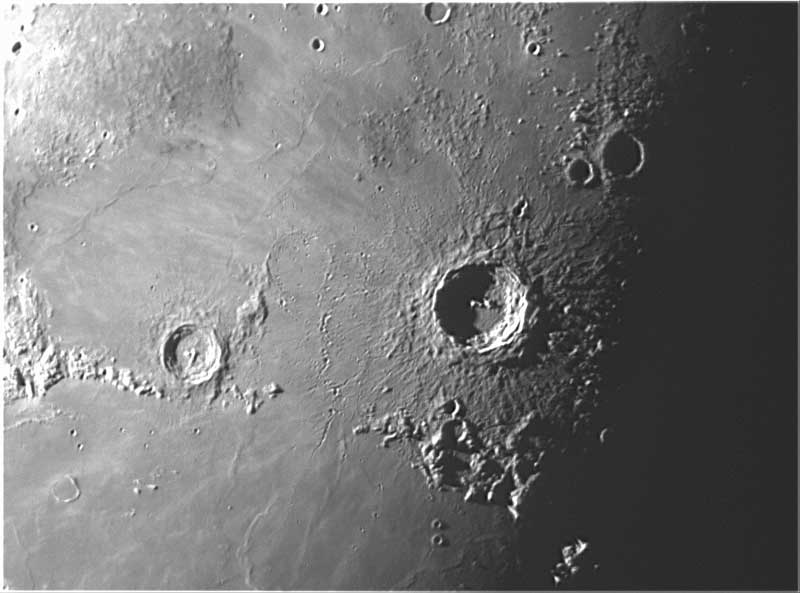
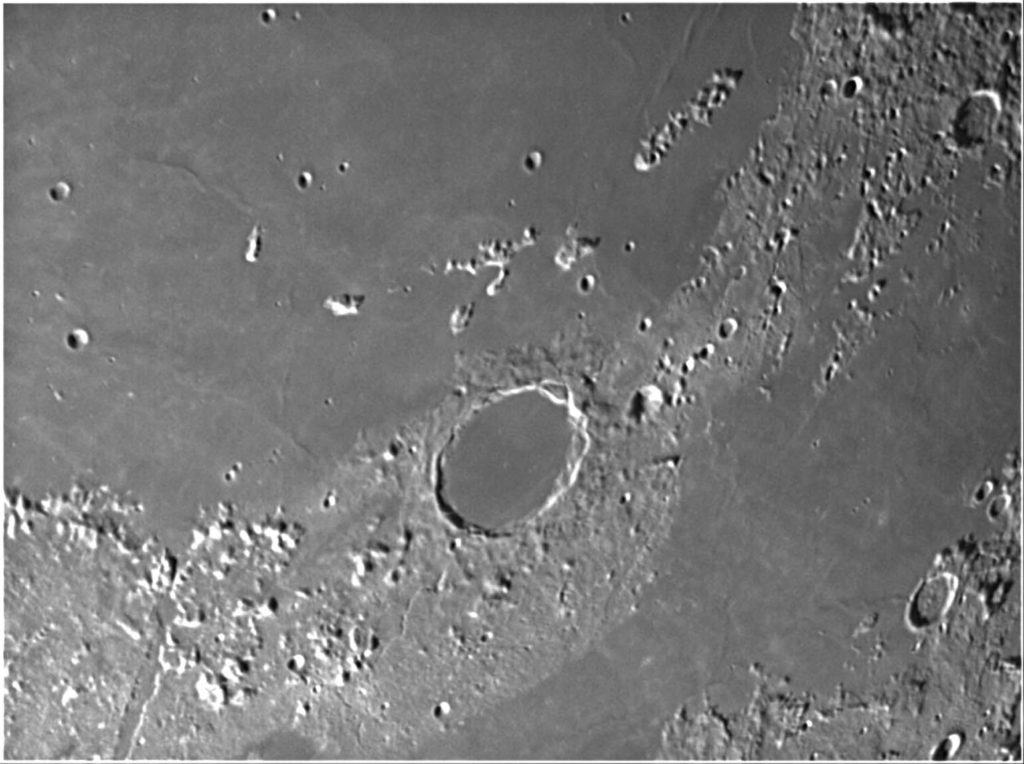
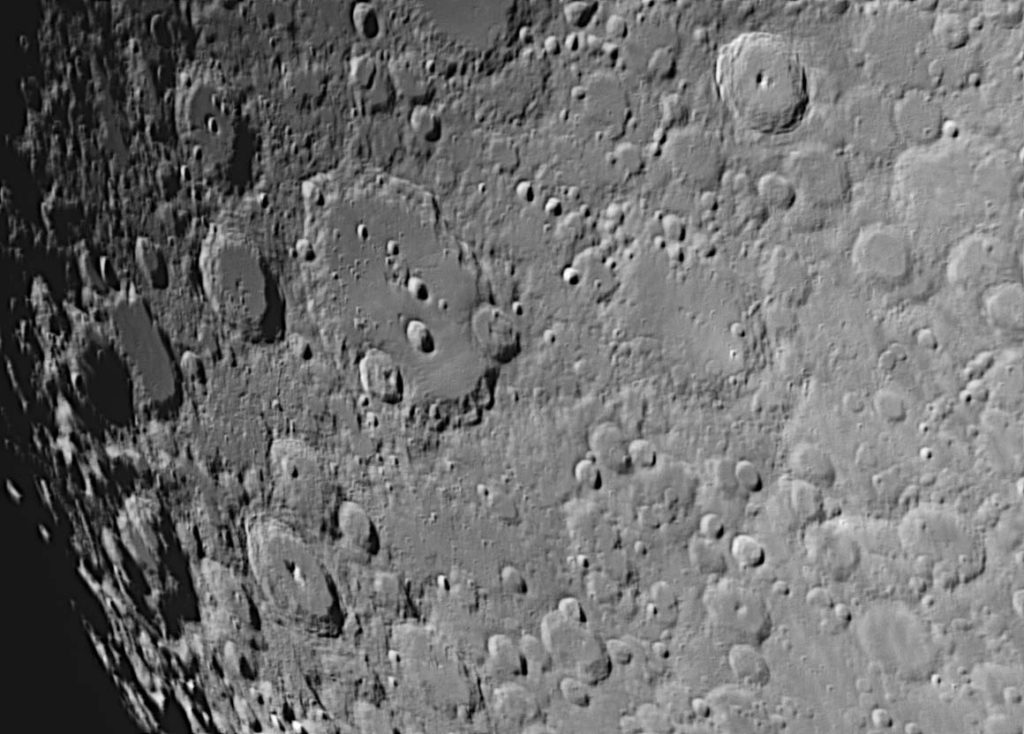
Copernicus
Copernicus is a lunar impact crater located in eastern Oceanus Procellarum. It was named after the astronomer Nicolaus Copernicus.
It typifies craters that formed during the Copernican period in that it has a prominent ray system. It may have been created by debris from the breakup of the parent body of asteroid 495 Eulalia 800 million years ago. It is 93 km in diameter.
Plato
Plato is a lava-filled lunar impact crater on the Moon. Its diameter is 101 km. It was named after ancient Greek philosopher Plato. It is located on the northeastern shore of the Mare Imbrium, at the western extremity of the Montes Alpes mountain range.
Close examination will show a few tiny caters in the dark lava filled area.
Clavius
Clavius is one of the largest crater formations on the Moon and the second largest crater on the visible side. It is located in the rugged southern highlands of the Moon. It is 231km in diameter and has a depth of 3.5 km.
The prominent feature is an arc of smaller craters inside as well as some even smaller ones dotted arounf in its base.
2. THE MILKY WAY GALAXY
The diameter of the solar system out to the orbit of Pluto is about 526 light minutes. The nearest star is 4.2 light years away. That is 4.2 x 365 light days, 4.2 x 365 x 24 light hours which is 4.2 x 365 x 24 x 60 light minutes. This works out at nearly 2,208,000 light minutes. This is 2,208,000/526 times as far as the diameter of the Solar System out to Pluto. This works out at 4200. To get to the nearest star we would have to travel 4200 solar system diameters. Most of space in pretty empty!
In the Milky Way Galaxy there are about 250 BILLION stars. Each star is like our sun giving out heat and light. Some are smaller some are much bigger. The Sun is a pretty average star. Most stars are separated at the sort of distance our sun is from the nearest star. So to say the Milky Way Galaxy dwarfs the Solar System can be seen as a serious understatement.
How are the stars distributed in the Galaxy? Imagine two dinner plates, one upside down placed with their rims touching. The space inside the two plates is a rough description of the space occupied by stars in the Galaxy. The stars are not evenly distributed but tend to form along spiral arms. Here are two photographs of galaxies further out in space that show roughly what the Milky Way galaxy would look like if we see it face on and edge-on.
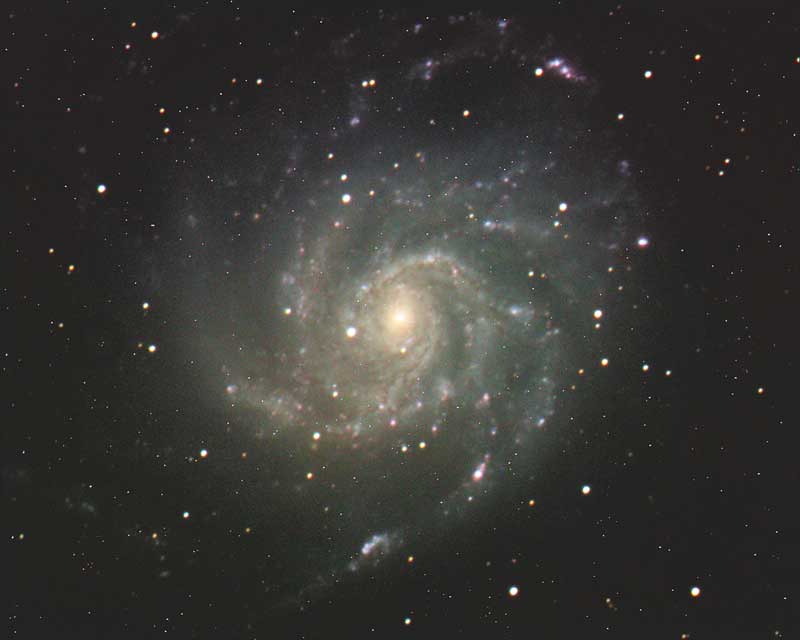
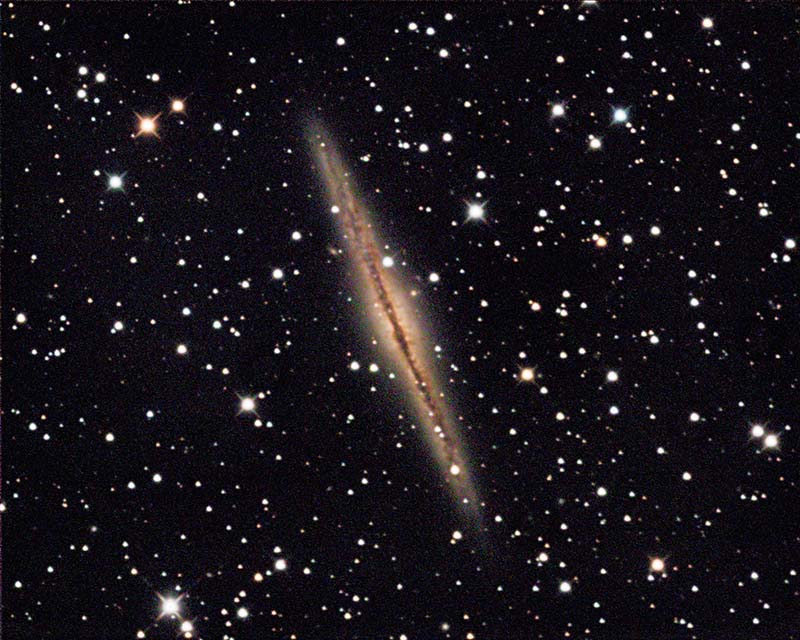
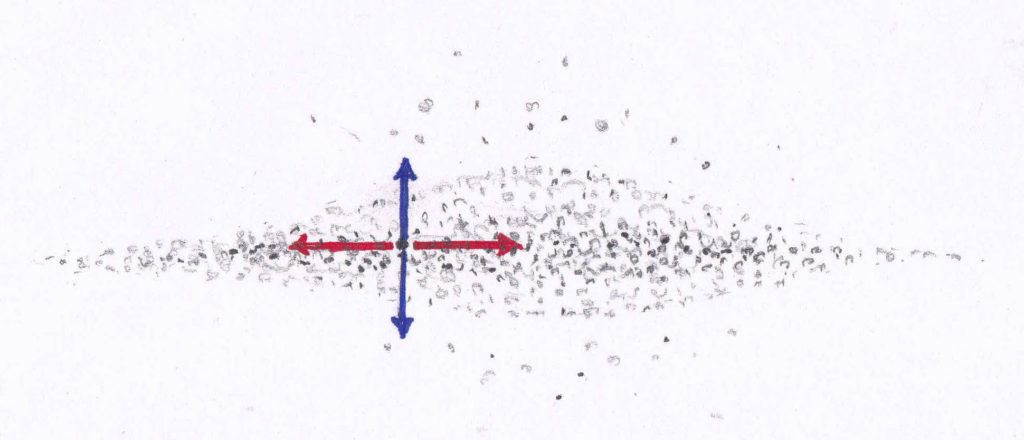
Why is it called the Milky way galaxy?
Imagine you are a tiny fly hovering in the space between the plates (in the sketch on the left) about half way from the centre to the edge of the plates. If you were to look upwards, in the direction of the blue arrows, you would be looking through a comparatively short distance to the limit of the galaxy. So there would not be many stars in the line of sight. If however you were to look towards the edges of the plates, in the direction of the red arrows, there would be many more in the line of sight.
In the real galaxy these many more stars when you look to the edge is the actual Milky Way. This is why our galaxy is called the Milky Way.
Why is it “milky” in appearance? When you look into mist, or fog, or steam you are looking at a myriad of tiny droplets. You see the effect of the individual droplets as a continuous mist. When you look into the milky way you are looking at a myriad of stars. These will be at differing distances and quite far from one another, but the distance to them is so great that they appear very close together and the light merges to form a milky mist. Hence the name Milky Way.
What objects are there in the Milky Way Galaxy? Other than stars the main types of things that can be see are Nebulae and Globular Clusters.
Nebulae. A nebula is an area of gas or dust. The gas may be hot caused by the gas and dust collapsing. These give out light and are called emission nebulae. Other areas may not be hot but dense enough to reflect light from nearby stars. These are called reflection nebulae. If areas of dust are in front of other nebulae they simply absorb the light, so we see them as dark clouds. These are dark nebulae. The areas of emission nebulae are often areas where the hot gases are slowly condensing to form stars – they are areas of star formation. Even so if you were in a spaceship and flew through a nebula you would hardly notice as the gases are still near a vacuum in density. A region of a nebula the size other the earth would only contain as much matter as in a bag of sugar.
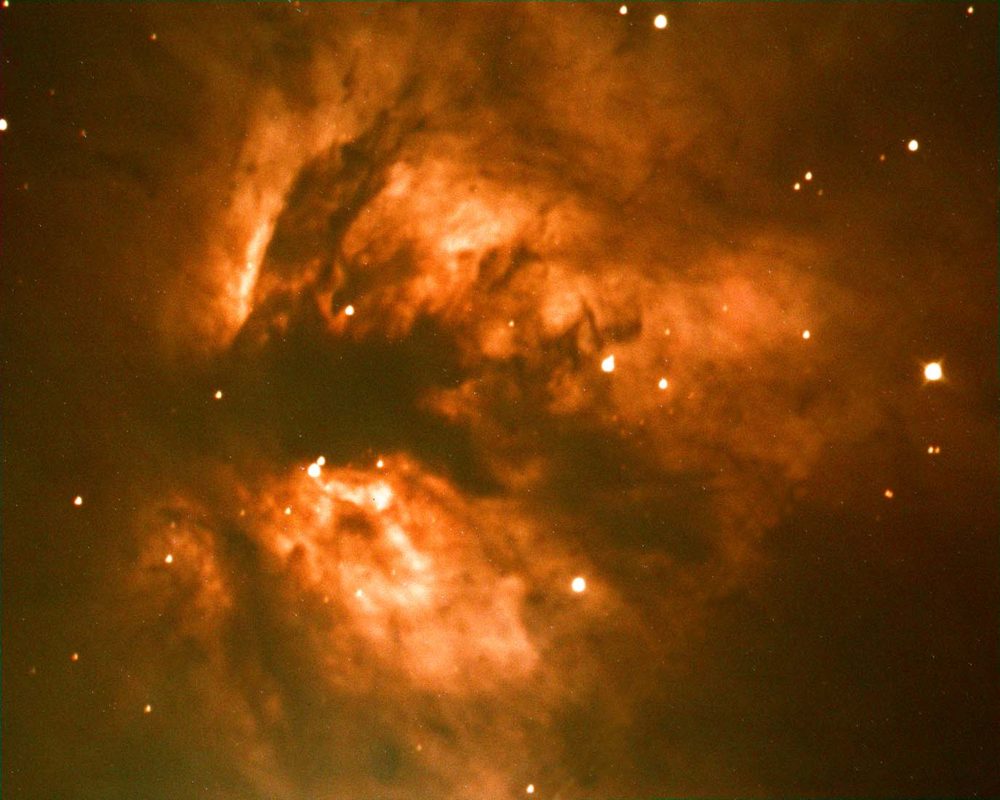
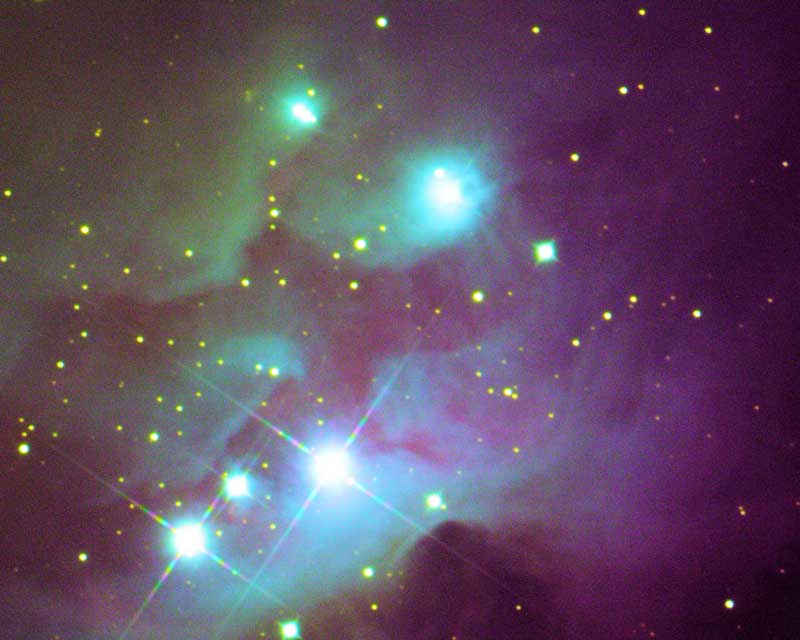
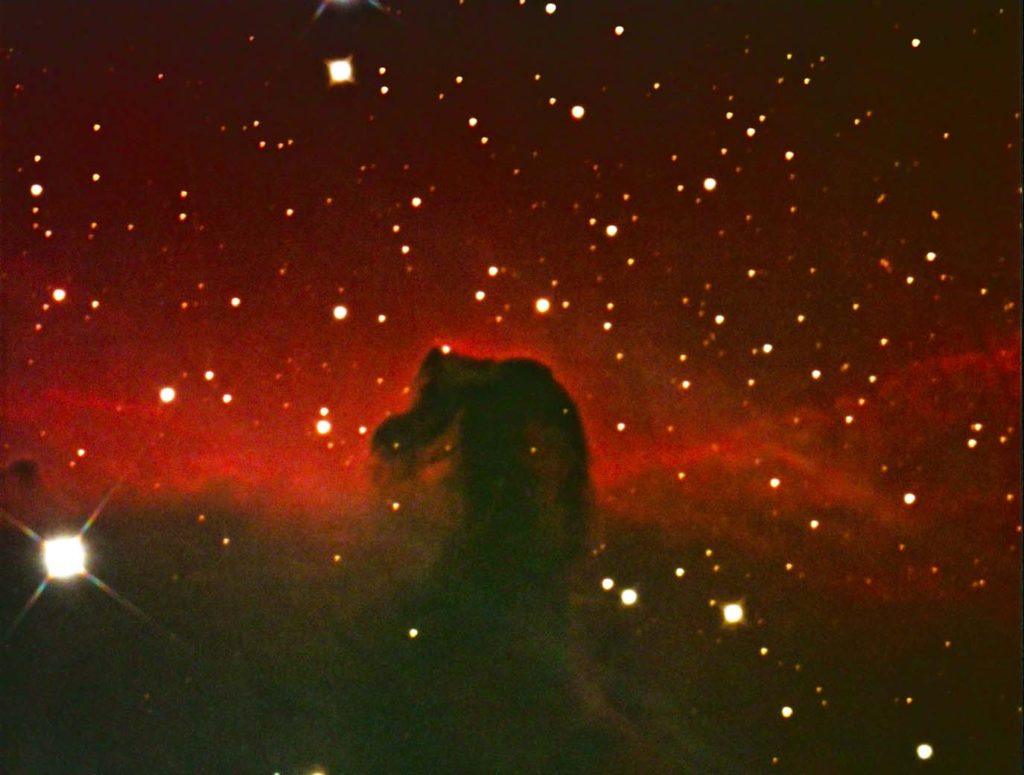
The “flame” nebula. An emission nebula with dark nebula material in front giving the effect of a flame.
The “running man” nebula. The blue sections are reflection nebulae. The are also dark nebulae which give the appearance of a man running with arms outstretched.
The famous “horsehead” nebula. A dark nebula in the shape of a horsehead obstructing the background emission nebula.
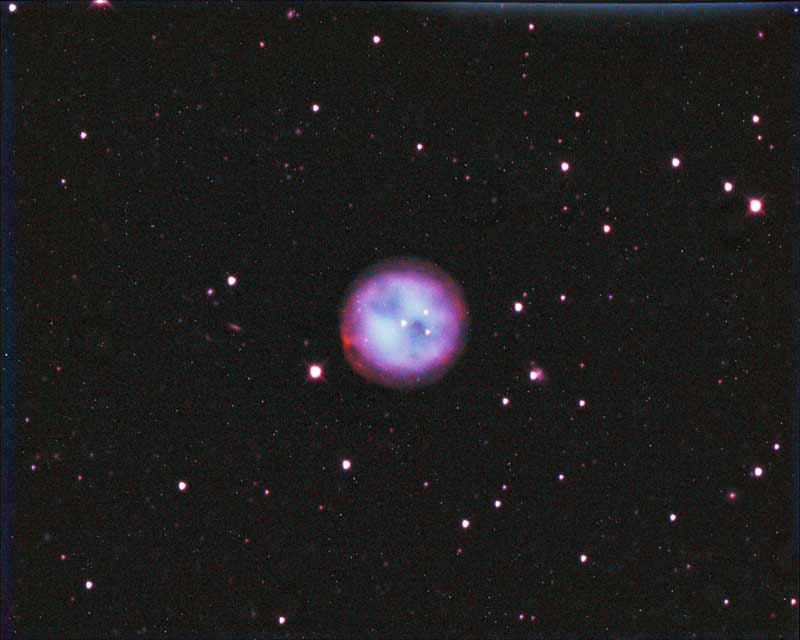
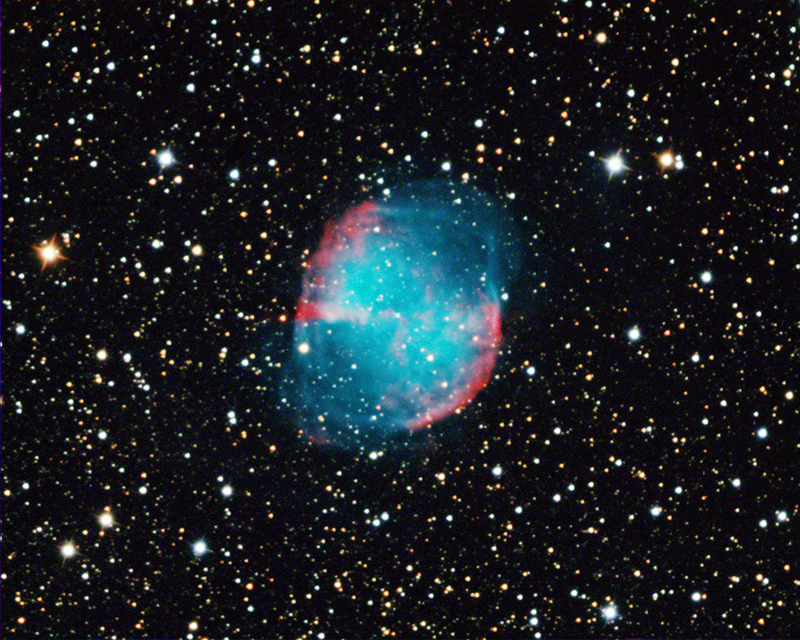
Another type of nebula is formed when a star dies. This is often accompanied by a drastic explosion throwing out gas and sometimes leaving a much smaller star – a white dwarf – at the centre of the nebula. These are called planetary nebulae (because they tend to be circular – but have nothing to do with planets). Here are two images of such nebulae. The “owl” nebula is on the left and the “dumbbell” nebula on the right.
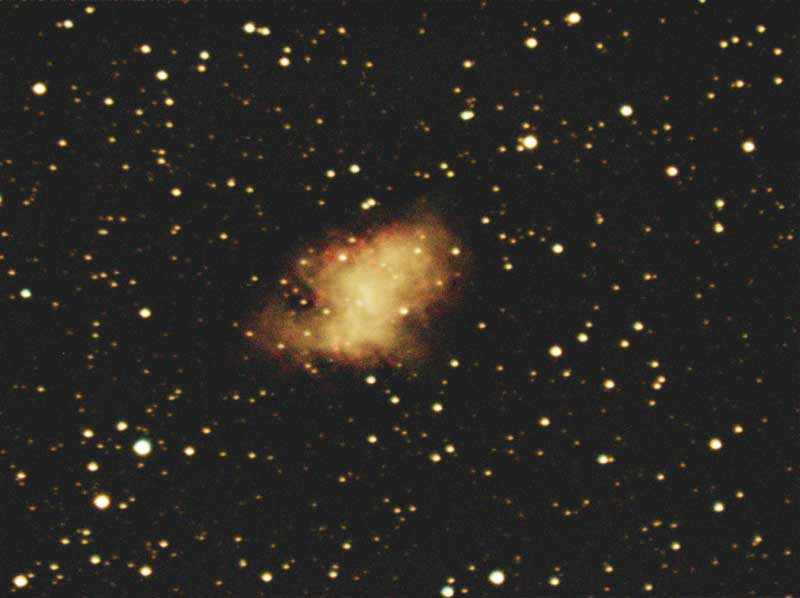

Sometimes when a larger star explodes there is a supernova. This can leave behind something much less structured. The crab nebula is an example which was recorded as a supernova explosion by Chinese astronomers in 1054. The image on the left shows what we see today.
Globular Clusters. These are strange objects. The image below shows a globular cluster of over 100,000 stars. Globular clusters are some of the oldest objects in the Galaxy. Unlike most stars and nebulae, they tend to live above and below the plates in the “two plate” model.
3. THE UNIVERSE BEYOND
In the 1920s all objects observed in the sky were thought to be in the Milky Way galaxy. This was thought to be the complete universe. What we now call the Andromeda Galaxy was seen as a diffuse shape and so thought to be a nebula, and was therefore called the Andromeda Nebula. The debate was settled conclusively in 1925 when Edwin Hubble observed a particular type of variable star called a Cephid variable within the Andromeda Nebula The brightness of this type of star varies regularly and it was found the time period for this regularity was related to how bright the star was. This means that if know the time period of a cephid variable and how bright it appears, knowing the real brightness enables us to know how far away it is. Using this Hubble deduced that the Andromeda Nebula was at a huge distance – well outside our Milky Way galaxy and was a whole galaxy in its own right. So it must be called the Andromeda Galaxy.
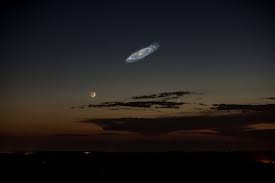
The Andromeda Galaxy
We now know that it is somewhat larger than the Milky Way galaxy and contains about 1 trillion stars. On a clear night with ideal conditions and little light pollution its brighter centre is just visible with the naked eye. And it is about 2.5 million light years away. (Often, I am asked how far an your telescope see. I usually reply by the question how far can you see with your naked eye. On a clear, light pollution free night, it is 2.5 million light years.)
The Andromeda Galaxy is so large that if your eyes were sensitive to see all of it, then it would appear in the sky much larger than the moon, as the image on the left illustrates. (Composite photo by Tom Buckley-Houston)
Given its very great distance, to appear this size in the night sky the galaxy must be very large. It is about 220,000 light years in diameter.
Our own galaxy is 100,000 light years in diameter. The Andromeda galaxy is at a distance 25 times as large as this. Also it is moving towards us and we are due to “collide”; but in about 4.5 billion years.
The Andromeda Galaxy is the nearest galaxy to us and is a member of what is called the local group. The images that follow show some of the galaxies I have photographed at ever increasing distance. Because the same camera was not used for all of them, they are not to scale but their actual size (where known) is stated by each image. M numbers relate to the “Messier” catalogue created by Charles Messier in the late 1700s. He would have seen many of these as just a small, faint fuzz.
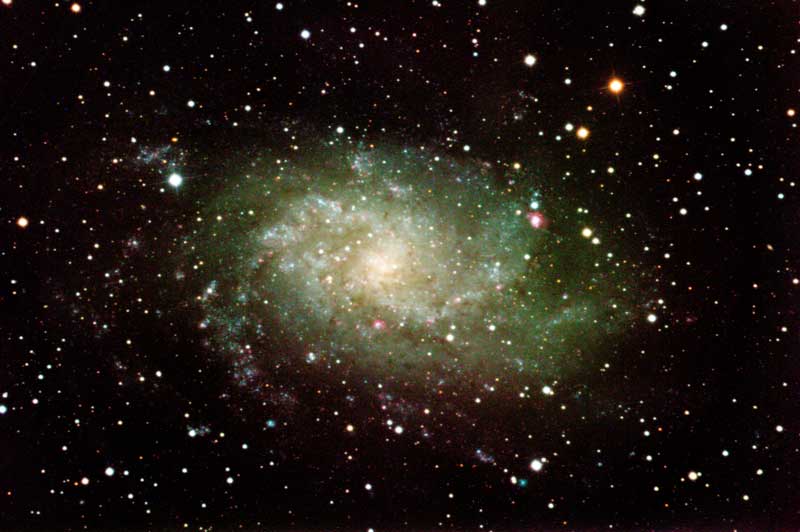
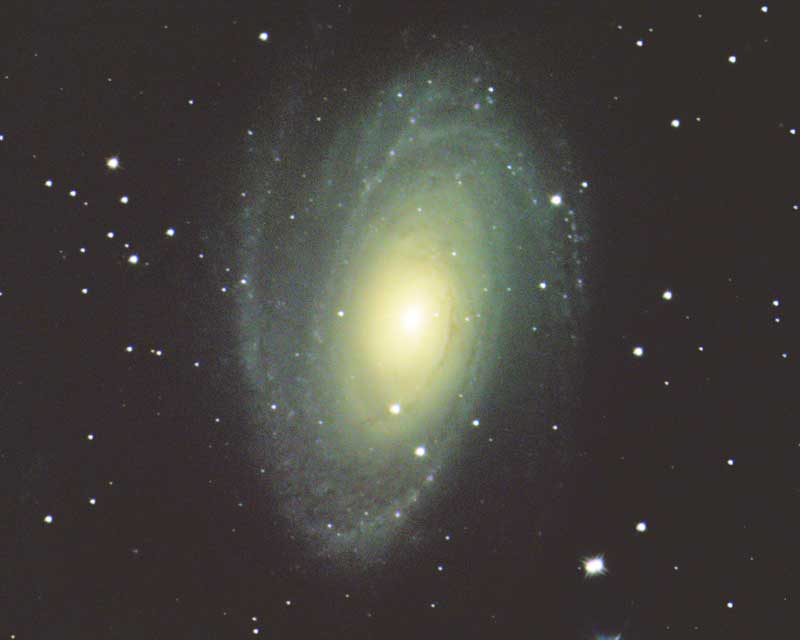

M33 – the Triangulum galaxy. Distance: 3.2 million light years (Mly). Diameter: 60 thousand light years (kly). 40 billion stars
M81 – Bode’s galaxy. Distance: 12Mly. Diameter 90 kly. 250 billion stars.
M101 – Pinwheel galaxy. Distance 21Mly. Diameter 100 kly. 1 trillion (1000 billion) stars.
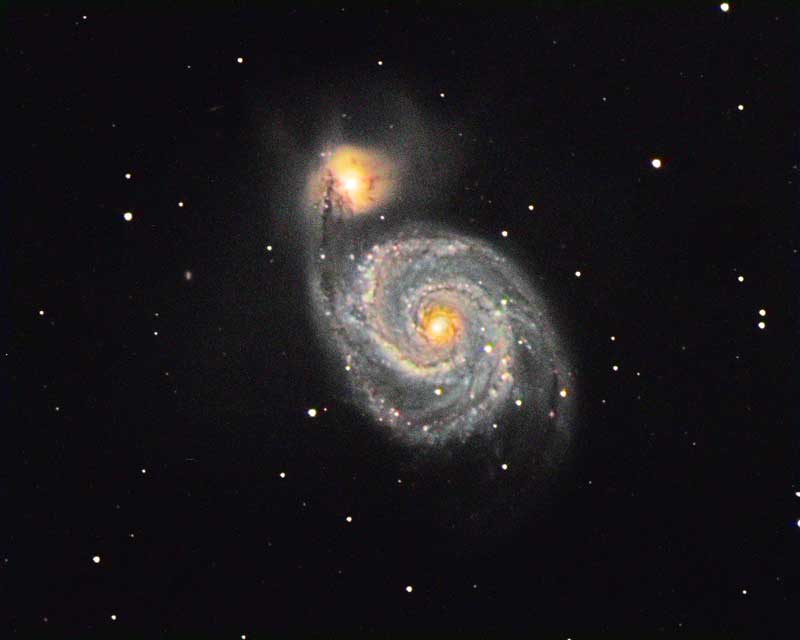
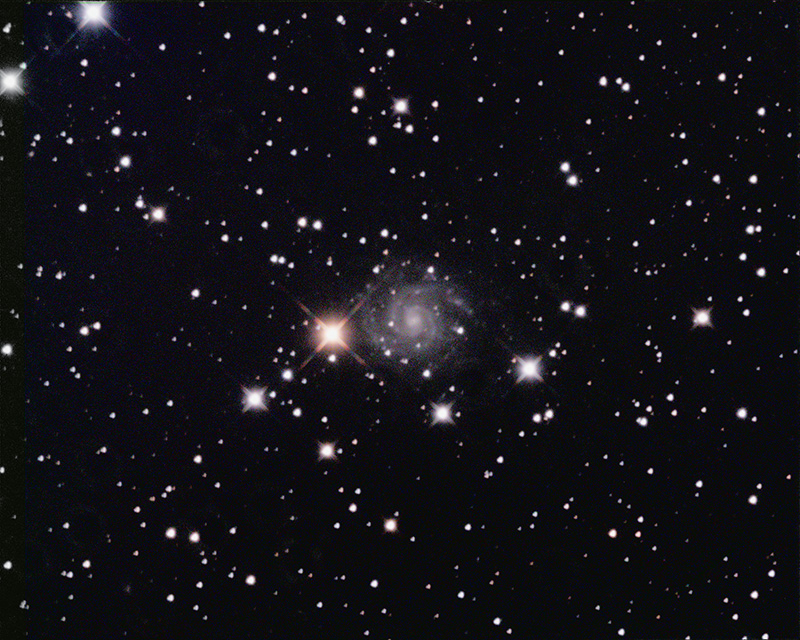
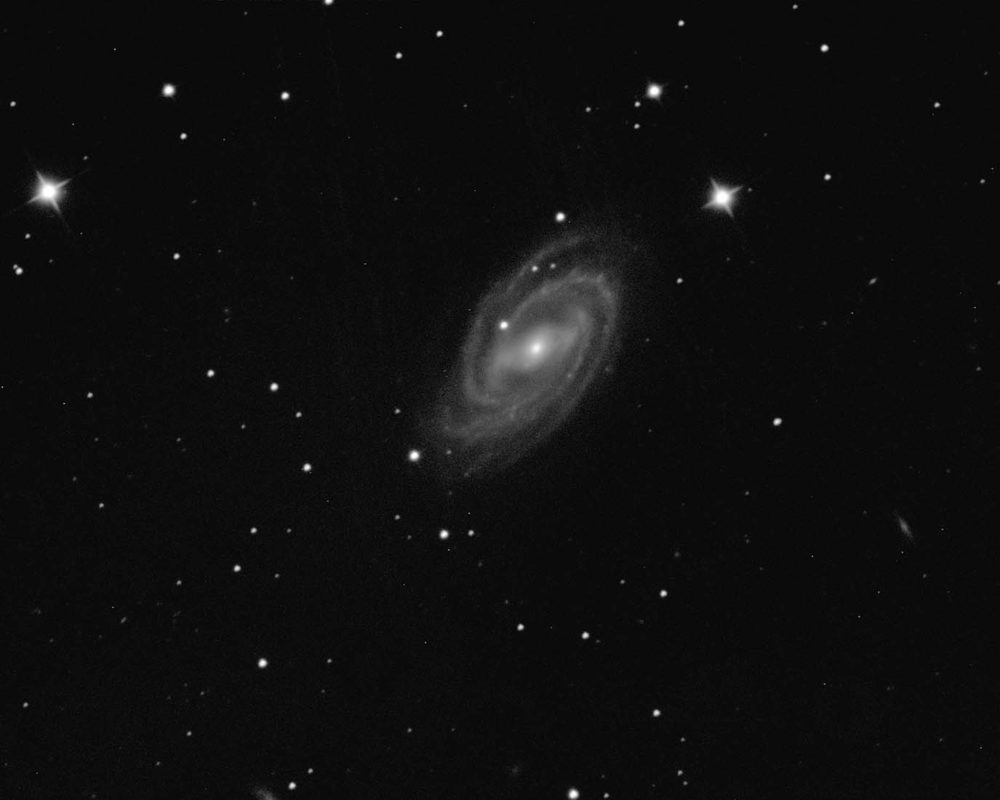
M51 – Whirlpool galaxy. Interacts with another smaller galaxy. Distance: 31 Mly. Diameter 76 kly. 160 billion stars.
IC 239 A faint face on galaxy. Web information is contradictory but the distance data given ranges from 37 – 51 Mly.
M109 – not in the original Messier catalogue but added later. It is the most distant in the catalogue at 85 Mly.
There are at least 2 trillion galaxies in the observable universe. The size is of the order of 100 Giga light years. That is 100,000,000,000 light years which is 40,000 times the distance of the Andromeda Galaxy. It is still true that most of the universe is empty. If all the material were spread evenly then you would find only 6 hydrogen atom in each cubic meter of space. An object the size of the earth at this density would have a mass of about 1/100 of a gram – about one hundredth the mass of a paper clip.
Taking it in?
With images of all the amazing objects in the Universe it is easy to forget how utterly insignificant the Earth is in the grand scheme of things.
Here is a recap.
If the solar system were the size of a cricket field, the Earth would be about the size of a small ball bearing.
To fit the nearest star on the cricket field the whole solar system would need to be shrunk to the size of a 50p piece. (Where would the Earth be in that?)
To get the whole Milky Way Galaxy onto the cricket ground the Solar System now becomes invisible. We have to shrink everything another 25,000 times. This makes the solar system diameter about 1/50th of a human hair.
To go further sticking to this scale when there are 2 trillion galaxies taking us to a distance some 100,000 times diameter of our galaxy, is mind blowing. The solar system shrinks to about 1/10 the size of a single atom.
Space is BIG, space is very nearly EMPTY, the Earth, our home, is totally insignificant. But don’t let it depress you!
Look at it the other way round. There are 2 trillion galaxies, each has billions of stars, a good proportion will have a planetary system. Some of those planets will be in the “goldilocks” zone capable of evolving organic life. It is fairly sure we are not alone.